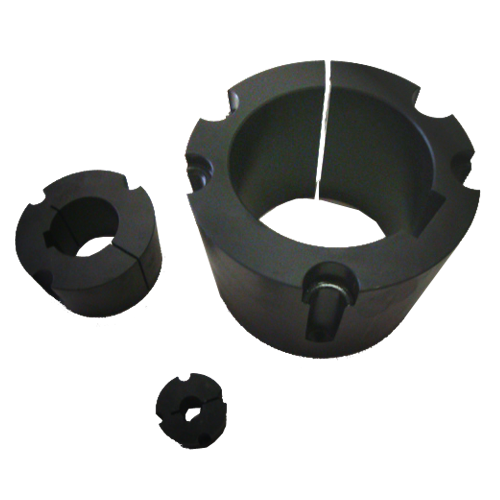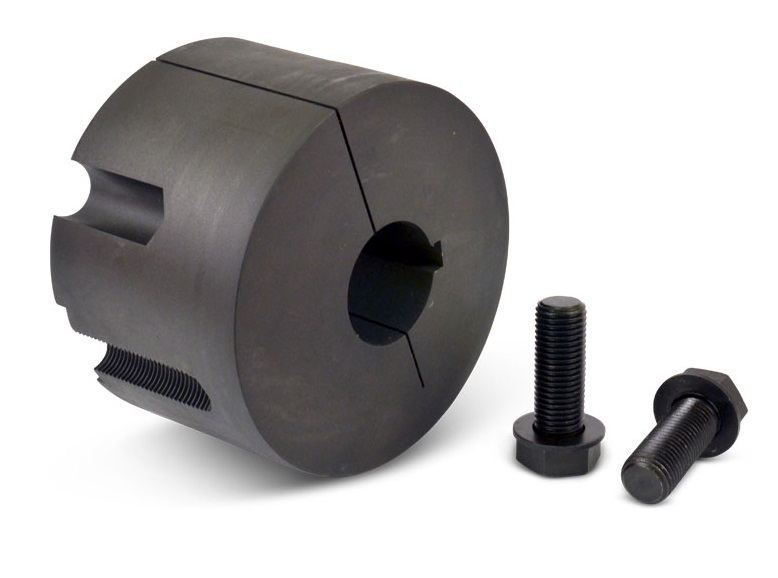Product Description
QD/STB/TB Bushings for V Belt Pulley
| Bushing No. | Bore |
| 1008 | 10.11.12.14.15.16.18.19.20.22.24.25 |
| 1108 | 10.11.12.14.15.16.18.19.20.22.24.25.28 |
| 1210 1215 | 11.12.14.15.16.18.19.20.22.24.25.28.30.32 |
| 1310 | 14.15.16.18.19.20.22.24.25.28.30.32.35 |
| 1610 1615 | 14.15.16.18.19.20.22.24.25.28.30.32.35.38.40.42 |
| 2012 2017 | 18.19.20.22.24.25.28.30.32.35.38.40.42.45.48.50 |
| 2517 2525 | 20.22.24.25.28.30.32.35.38.40.42.45.48.50.55.60 |
| 3571 3030 | 25.28.30.32.35.38.40.42.45.48.50.55.60.65.70.75 |
| 3525 3535 | 35.38.40.42.45.48.50.55.60.65.70.75.80.85.90 |
| 4030 4040 | 40.42.45.50.60.65.70.75.80.85.90.95.100 |
| 4535 4545 | 55.60.65.70.75.80.85.90.95.100.105.110 |
| 5040 5050 | 60.65.70.75.80.85.90.95.100.105.110.115.120.125 |
Use:
Mainly used in the mining, metallurgical, cement, chemicals,construction, buiding materials,
electric power, telecommunictions, textiles, and transportation departments.
Such as:
1. conveyor:Belt conveyor,AFC conveyor, chain conveyor, screw conveyor.
2. Pum:Water pump, oil pump, slush pump, etc.
3. Fan: Draft fan, fanner, boil fan, etc.
4. Excator:bucket excavator bucket, wheel excavators .
5. Crane:Tower crane, gantry crande, bridge crane.
6. Others:Various elevators, coal plough, ball mill, crusher, recreation machine.
7. Blender equipment, centrifuger, washer, leather-making machine, machine for recreation park mixer wire drawing machine.Extruder, dregs crusher of boiler.
8. Plastic feeder, rubber smelling machine, etc.
Main Products:
1. Timing Belt Pulley (Synchronous Pulley), Timing Bar, Clamping Plate;
2. Forging, Casting, Stampling Part;
3. V Belt Pulley and Taper Lock Bush; Sprocket, Idler and Plate Wheel;Spur Gear, Bevel Gear, Rack;
4. Shaft Locking Device: could be alternative for Ringfeder, Sati, Chiaravalli, Tollok, etc.;
5. Shaft Coupling:including Miniature couplings, Curved tooth coupling, Chain coupling, HRC coupling, Normex coupling, Type coupling, GE Coupling, torque limiter, Universal Joint;
6. Shaft Collars: including Setscrew Type, Single Split and Double Splits;
7. Gear & Rack: Spur gear/rack, bevel gear, helical gear/rack
8. Other customized Machining Parts according to drawings (OEM).
More Advantages:
1. More competitive prices,
2. Shorter delivery date: 35 days for out of stock products.
3. We are the professional manufacturer in the field of Power Trans. Parts,specially for Timing Pulleys.
4. Produce standard and non-standard
5. Strict QC Management:ISO9001:2008,our engineer,Mr.Wang has specialized in the prodcution for over 20 years.
Packaging & Shipping:
All the products can be packed in cartons,or,you can choose the pallet packing.
MADE IN CHINA can be pressed on wooden cases.Land,air,sea transportation are available.UPS,DHL,TNT,
FedEx and EMS are all supported.
Company:
Factory View:
FAQ:
1. MOQ
A: Generally, 1 pc for standard parts; contact for nonstandard parts.
2. Delivery Time
A: In stock: within 5 working days. Out of stock: depends on your order quantity.
3. How To Select
A: part number or drawing, catalogue. If no, you can send us your sample, so we can make the drawing and sample accordingly.
4: What is the Warranty for your products?
A:Normally our warranty is 1 year.
Contacts:
| Certification: | ISO |
|---|---|
| Pulley Sizes: | 1008, 1108, 1210,1610,2517, 3020, 3030 etc. |
| Material: | Cast Iron, Steel |
| Surface Treatment: | Black Oxide, Phosphating |
| Application: | Chemical Industry, Grain Transport, Mining Transport, Power Plant, etc. |
| Size: | Metric & Inch |
| Samples: |
US$ 1/Piece
1 Piece(Min.Order) | |
|---|
| Customization: |
Available
| Customized Request |
|---|

Are there guidelines for lubricating pulley bushings, and what lubricants are recommended?
Yes, there are guidelines for lubricating pulley bushings, and specific lubricants are recommended to ensure proper operation and longevity of the bushings. Here are some general guidelines and recommendations:
- Manufacturer’s Recommendations: The best source of information on lubricating pulley bushings is the manufacturer of the bushing itself. The manufacturer typically provides guidelines and recommendations regarding the lubrication requirements for their specific bushing products. These recommendations may be available in the product documentation, installation manuals, or technical specifications provided by the manufacturer. It is important to follow the manufacturer’s guidelines to ensure optimal performance.
- Cleanliness: Before lubricating pulley bushings, it is crucial to ensure that the bushings and the surrounding area are clean. Remove any dirt, debris, or old lubricant residues from the bushings and the shaft. Cleanliness helps to prevent contamination and ensures proper lubricant distribution.
- Lubricant Type: The choice of lubricant depends on factors such as the bushing material, operating conditions, temperature, and load. Common lubricant types used for pulley bushings include grease and oil. Grease is often preferred for its ability to provide long-lasting lubrication, while oil may be used for applications with high speeds or specific requirements. It is recommended to consult the manufacturer’s guidelines or contact them directly to determine the appropriate lubricant type for the specific bushing.
- Appropriate Lubricant Grade: Lubricants come in different grades or viscosities, and the appropriate grade depends on the operating conditions. Higher viscosities are generally suitable for heavy-duty applications or higher loads, while lower viscosities are used for lighter loads or high-speed applications. The manufacturer’s recommendations or technical documentation can provide guidance on the appropriate lubricant grade for the specific application.
- Lubrication Interval: Establishing a regular lubrication schedule is important to maintain optimal performance of pulley bushings. The lubrication interval depends on factors such as operating conditions, loads, and the type of lubricant used. Some bushings may require lubrication at specific time intervals or operating hours, while others may have longer intervals. The manufacturer’s recommendations should specify the appropriate lubrication interval.
- Proper Lubrication Method: Follow the recommended lubrication method provided by the bushing manufacturer. This may involve applying the lubricant directly to the bushing, using a grease gun or oiler, or following specific instructions for lubricant application. Proper lubrication method ensures effective distribution of the lubricant within the bushing and minimizes excess or inadequate lubrication.
It is important to note that different pulley bushing manufacturers may have specific lubrication requirements or recommendations. Therefore, consulting the manufacturer’s guidelines, product documentation, or contacting their technical support is crucial to ensure proper lubrication practices for the specific pulley bushings being used.

Can I get recommendations for pulley bushings suitable for use in automotive or conveyor systems?
Yes, you can get recommendations for pulley bushings suitable for use in automotive or conveyor systems. Pulley bushings play a critical role in power transmission and ensuring the smooth operation of automotive and conveyor systems. When seeking recommendations, it is important to consider factors such as the specific application requirements, including load capacity, speed, environmental conditions, and the type of belt being used. Here are some sources where you can find recommendations for pulley bushings:
- Pulley Manufacturers: Pulley manufacturers often provide recommendations for pulley bushings suitable for their specific pulley products. They may offer a range of bushing options that are designed to work well with their pulleys in automotive or conveyor systems. Checking the manufacturer’s product documentation, catalogs, or contacting their customer support can provide valuable recommendations based on their expertise and experience.
- Belt Manufacturers: Belt manufacturers also provide guidance on pulley bushing recommendations for their specific belt products. They understand the unique requirements of different applications and can offer suggestions for compatible bushing options. Reviewing the belt manufacturer’s documentation, technical guides, or contacting their customer support can help you find suitable pulley bushing recommendations.
- Industry Associations and Standards: Industry associations and organizations related to automotive or conveyor systems may have established guidelines or standards that recommend specific pulley bushings. For example, the Power Transmission Distributors Association (PTDA) or the Conveyor Equipment Manufacturers Association (CEMA) may provide resources or publications that outline recommended bushing types for different applications. Visiting their websites or contacting these organizations can provide access to valuable recommendations based on industry standards.
- Engineering Consultants: Consulting with engineering consultants or specialists who have experience in automotive or conveyor systems can provide expert recommendations. These professionals have practical knowledge and can offer insights into suitable pulley bushings based on their experience with similar applications. Engaging with engineering consultants or seeking professional advice can help you make informed decisions.
- Online Forums and Communities: Online forums and communities dedicated to automotive or conveyor systems can be valuable sources of recommendations. Engaging with professionals, enthusiasts, or individuals with experience in these systems can provide insights into suitable pulley bushings. Posting specific questions or sharing your requirements in these forums can lead to recommendations based on real-world experiences.
When seeking recommendations for pulley bushings, it is crucial to provide detailed information about your specific application requirements. This includes the type of system (automotive or conveyor), load capacity, speed, and any environmental factors. The more specific and accurate the information you provide, the better the recommendations you will receive.
It’s important to note that the final selection of pulley bushings should be based on a thorough evaluation of the specific application requirements and consulting with experts or manufacturers to ensure compatibility and optimal performance.

What is the purpose of a pulley bushing in mechanical systems?
A pulley bushing serves an essential role in mechanical systems, specifically in the assembly and operation of pulley systems. It is a component designed to provide support, alignment, and rotational motion for pulleys. Here is a detailed explanation of the purpose of a pulley bushing:
1. Support and Alignment:
– The primary purpose of a pulley bushing is to provide support and alignment for the pulley. It serves as a mounting point or interface between the pulley and the shaft on which it is installed.
– The bushing ensures that the pulley is securely and accurately positioned on the shaft, maintaining proper alignment with other components in the system. It helps prevent misalignment, excessive vibrations, and premature wear of the pulley and associated components.
2. Rotational Motion:
– A pulley bushing facilitates the smooth and efficient rotational motion of the pulley. It acts as a bearing surface that allows the pulley to rotate freely on the shaft.
– The bushing reduces friction between the pulley and the shaft, minimizing energy losses and wear. It enables the pulley to rotate with minimal resistance, promoting efficient power transmission and motion transfer within the mechanical system.
3. Load Distribution:
– In pulley systems, the bushing helps distribute loads evenly across the shaft and the pulley. It helps prevent localized stress concentrations that could lead to premature failure or damage to the pulley or the shaft.
– By providing a larger bearing surface area, the bushing spreads the load over a wider region, reducing the pressure on specific points of contact. This improves the overall strength and durability of the pulley system, allowing it to handle higher loads and operate more reliably.
4. Shaft Protection:
– A pulley bushing also serves to protect the shaft from wear and damage caused by the rotational motion of the pulley. It acts as a barrier between the pulley and the shaft, reducing direct contact and minimizing frictional forces.
– The bushing can be made from materials that offer excellent resistance to wear, such as bronze, plastic, or self-lubricating materials. These materials help minimize abrasion and extend the lifespan of the shaft, ensuring the longevity and performance of the pulley system.
5. Easy Installation and Maintenance:
– Pulley bushings are designed for easy installation and maintenance. Many bushings feature a split design, allowing them to be easily mounted or removed from the shaft without disassembling the entire pulley system.
– This split design simplifies maintenance tasks such as pulley replacement or system adjustments, reducing downtime and improving the overall efficiency of the mechanical system.
In summary, the purpose of a pulley bushing in mechanical systems is to provide support, alignment, and rotational motion for pulleys. It ensures proper positioning, enables smooth rotation, distributes loads, protects the shaft, and facilitates easy installation and maintenance. By performing these functions, the pulley bushing contributes to the overall performance, efficiency, and longevity of pulley systems in various applications.


editor by CX 2023-10-27
